-
-
 Energy and Climate Databases
Energy and Climate Databases- The most comprehensive and up-to-date annual energy database.
- Monitoring of technology providers in H2 supply chain.
- Monthly energy data on key energy markets.
- The most reliable and up-to-date power generation database.
- The essentials of LNG trade at your fingertips.
- Global monitoring of new and existing refineries.
- Analyse energy consumption and efficiency trends at world level. Benchmark countries.
- Have your database developed by a recognised expert of both energy and IT.
-
 Energy - Climate Forecasts
Energy - Climate Forecasts- Instant access to energy and emissions forecasts.
- Strategic, annual wholesale price projections backed by Enerdata's energy modelling expertise and our globally recognised POLES model.
- Wedges module showing a breakdown of the levers enabling to reduce emissions between two scenarios.
- Unique, independent projections of consumption by end-use.
- GHG Marginal Abatement Cost Curves.
- Benefit from proven models to draw your own energy scenarios and anticipate tomorrow’s challenges.
-
 Market Intelligence
Market Intelligence- 110 Energy and climate country reports
- A newsletter to receive the latest updates on evolving technologies and policies.
- Global energy news and analyses curated daily.
- Enerdata’s experts bring you the essentials about your market and competitors.
-
-
-
 Market Analysis
Market Analysis- Understanding key consumption trends and drivers across sectors.
- Granular and exclusive insight to address the most pressing business and strategic issues.
- Expertise in strategic and business intelligence, with fine-tuning to the market’s specificities.
-
 Energy - Climate Scenarios
Energy - Climate Scenarios- Providing the outlook of an energy commodity in mid to long term time horizons.
- Sector and driver specific energy demand forecasting.
- Assess the evolution of energy prices on the international and regional markets, as well as end-users prices.
- Enerdata guides you through pathways to reach climate targets.
- Supporting local authorities in their decarbonisation strategies.
-
 Climate Strategy and Policy Evaluation
Climate Strategy and Policy Evaluation- Cutting-edge quantitative tools and relevant indicators to monitor and evaluate evolutions on worldwide energy markets.
- Analysis of the most cost-effective options to reduce emissions.
- Quantified simulation and analysis of pledges for climate change negotiations.
- Breakdown and analysis of carbon markets.
- Enerdata guides you on the most beneficial policy or investment options.
- Turning climate objectives into concrete action plans.
-
 Training
Training- Understand different policy targets and measures on energy efficiency.
- How to measure energy savings?
- Energy Forecasting is a 2 days training to learn to design and interpret energy forecasts.
- Energy statistics training allowing to create energy balance with supply, transformation and consumption and understanding the international energy statistics regulations.
- Initiation to EnerMED level 1is the training to approach on the most powerful energy demand forecasting model.
-
-
Resource Centre
Lithuania Key Figures
- Population:
- 2.83 million
- GDP growth rate:
- 1.89 %/year
- Energy independence:
- 27.1%
Data of the last year available: 2022
- Total consumption/GDP:*
- 48.2 (2005=100)
- CO2 Emissions:
- 4.11 tCO2/capita
- Rate of T&D power losses:
- 6.95%
* at purchasing power parity
View all macro and energy indicators in the Lithuania energy report
Lithuania Related News
View all news, archive your new and create your own daily newsletters only on your topics/countries of interest with Key Energy Intelligence
Lithuania Related Research
Benefit from up to 2 000 up-to-date data series for 186 countries in Global Energy & CO2 data
A data overview is available in the global energy statistics app
Total Energy Consumption
Total energy consumption per capita is 2.4 toe and 4000 kWh for electricity (2022); those consumption rates are 18% and 27% below the EU average, respectively.
Graph: CONSUMPTION TRENDS BY ENERGY SOURCE (Mtoe)
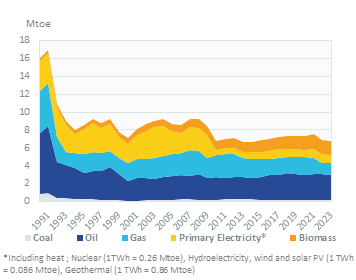
In 2022, total energy consumption dropped by 12% (6.8 Mtoe), after rising by 2% between 2015 and 2021.
The energy intensity to GDP fell by 4%/year between 2000 and 2022, compared to 2%/year in the European Union.
Interactive Chart Lithuania Total Energy Consumption
Benefit from up to 2 000 up-to-date data series for 186 countries in Global Energy & CO2 data
View the detailed fondamentals of the market at country level (graphs, tables, analysis) in the Lithuania energy report
Crude Oil Production
Apart from a marginal production of around 30 kt, Lithuania imports all its crude oil (8.4 Mt in 2022, mainly from Russia. It is refined at the Mazeikiai refinery which has a capacity of 15 Mt/year, and which operates at around 2/3 of its capacity. The country is a net exporter of oil products (6.3 Mt of exports for 1 Mt of imports in 2022).
Interactive Chart Lithuania Crude Oil Production
Benefit from up to 2 000 up-to-date data series for 186 countries in Global Energy & CO2 data
Additionally, for more detailed information on refineries, you can request a sample of our EMEA Refineries Dataset
Oil Products Consumption
Oil consumption has been rising by 2.3%/year since 2014, reaching 2.9 Mt (2022). It had remained broadly stable at around 2.5 Mt between 2000 and 2014, after nearly halving between 1992 and 2002.
Graph: OIL CONSUMPTION (Mt)
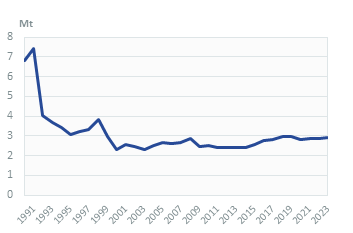
In 2022, transport consumed nearly 2/3 of the country's oil products (65%), followed by power generation with 21%.
Graph: OIL CONSUMPTION BREAKDOWN BY SECTOR (2022, %)
Interactive Chart Lithuania Refined Oil Products Production
Benefit from up to 2 000 up-to-date data series for 186 countries in Global Energy & CO2 data
Additionally, for more detailed information on refineries, you can request a sample of our EMEA Refineries Dataset
Natural Gas Consumption
Natural gas consumption dropped by 21% in 2022 to 1.5 bcm due to high gas prices that reduced domestic fertilizer production and gas-fired power generation, a warmer winter, and the decision to use oil in Vilnius district heating. It remained quite stable between 2016 and 2021 at around 2.2 bcm, after falling rapidly between 2011 and 2016 (-6%/year).
Industry accounted for 58% of total gas consumption in 2022 (including non-energy uses, mainly fertiliser production), followed by the residential-tertiary sector (17%) and power plants (16%).
Interactive Chart Lithuania Natural Gas Domestic Consumption
Benefit from up to 2 000 up-to-date data series for 186 countries in Global Energy & CO2 data
Additionally, for more detailed information on the LNG trade, you can request a sample of our EMEA LNG Trade Dataset
Coal Consumption
Coal consumption has been fluctuating around 0.4 Mt since 2005 (0.4 Mt in 2022).
Buildings (residential-services sector) absorb 43% of the consumption, while industry (mainly non-metallic minerals) accounts for 51% (2022).
Graph: COAL CONSUMPTION (Mt)
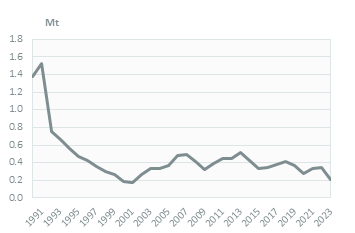
Graph: COAL CONSUMPTION BREAKDOWN BY SECTOR (2022, %)
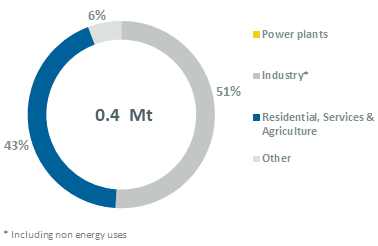
Interactive Chart Lithuania Coal and Lignite Domestic Consumption
Benefit from up to 2 000 up-to-date data series for 186 countries in Global Energy & CO2 data
View the detailed consumption trends at country level (graphs, tables, analysis) in the Lithuania energy report
Power Consumption
Electricity demand increased by 2.3%/year between 2010 and 2021, and fell by 4% in 2022 to 11.5 TWh. Previously, it had grown strongly between 2000 and 2008 (+4.6%, on average).
Graph: ELECTRICITY CONSUMPTION (TWh)
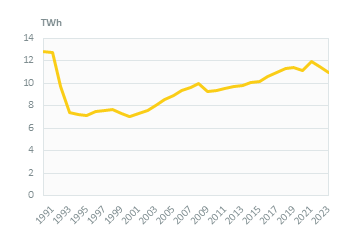
Industry absorbs 33% of electricity consumption, services 29%, and the residential sector 29% (2022). Those shares have remained broadly stable since 2000.
Graph: ELECTRICITY CONSUMPTION BREAKDOWN BY SECTOR (2022,%)
Renewable in % Electricity Production
The target of the National Renewable Energy and Climate Action Plan of a 23% share of renewables in final energy consumption has been exceeded since 2016 (29.6% in 2022, of which 51.5% for heating, 26.5% for power, and 6.7% for transport). The target set for renewables in 2030 in the updated NECP Draft is 55% of final consumption.
In 2021, the government announced the expected investment (€10 bn) to bring the share of green power to 50% by 2025 and 100% by 2050.
Interactive Chart Lithuania Share of Renewables in Electricity Production (incl hydro)
Benefit from up to 2 000 up-to-date data series for 186 countries in Global Energy & CO2 data
Learn more about renewables in the European Battery Market Analysis
CO2 Fuel Combustion/CO2 Emissions
GHG emissions have remained broadly stable since 2009, but fell by 58% between 1990 and 2021 (20.3 Mt). They had decreased by nearly 60% between 1990 and 2000 and risen by 30% between 2000 and 2007, offset by significant drops in 2008 and 2009.
Lithuania aims to cap the increase in GHG emissions in sectors covered by the EU ETS to 15% compared to the 2005 level (15.5 MtCO2eq). Ahead of the COP 21, Lithuania's NDC includes a binding GHG emission reduction of 55% by 2030 compared to 1990.